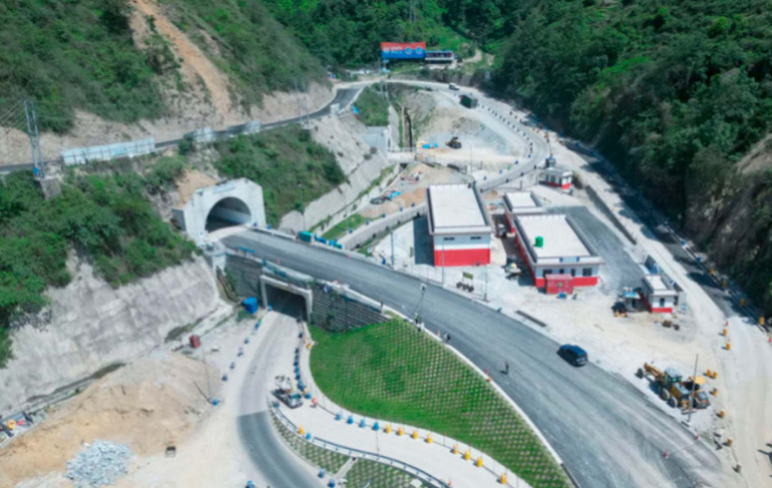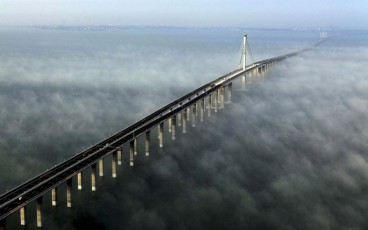Nepal’s First Highway Tunnel Nears Completion: The Nagdhunga–Sisnekhola Project

The Nagdhunga–Sisnekhola tunnel, Nepal’s first highway tunnel, is scheduled to open in January 2026. Project chief Saujanya Nepal confirmed that construction has reached its final stage, with only slope reinforcement near the Sisnekhola entrance remaining. Preparations for operation are underway, including the selection of the operating authority through bids to be invited within the next 15 days.
Testing of the tunnel’s critical systems is progressing. Jet fans, CCTV cameras, lighting, firefighting systems, and communication networks are undergoing comprehensive trials to ensure seamless integration. Landslide prevention work on the Dhading side, halted during the monsoon, will resume in September. On the Kathmandu side, the Kisipidi flyover has been completed, with road marking now in progress.
The 2,688-metre-long main tunnel is supported by a 2,557-metre emergency tunnel, designed to improve safety during unforeseen events. An approach road of 2.3 km, including bridges and toll booths, has also been built to facilitate smooth access.

The Cabinet has approved toll fees following recommendations from the Nepal Road Board. For the first two years, cars and vans will pay Rs65 when entering Kathmandu and Rs60 when exiting. Mini buses, trucks, and tippers will pay Rs115 entering and Rs80 exiting. Larger buses and trucks will be charged Rs260 entering and Rs200 exiting, while heavy trucks will pay Rs600 entering and Rs250 exiting. These rates are based on expected daily traffic volumes exceeding 3,000 vehicles.
Operation guidelines, issued in April, specify that pedestrians, two- and three-wheelers, bicycles, and non-motorised vehicles will not be permitted. Vehicles carrying flammable materials or explosives, as well as oversized and overloaded vehicles, will also be restricted.
Construction began in October 2019 with an initial 42-month schedule but faced delays due to the Covid-19 pandemic and local protests. Despite challenges, 94.5 percent of the project is now complete. The total cost is estimated at Rs22 billion, financed through a concessional loan from Japan and contributions from the Nepal government.
The tunnel is expected to reduce travel time between Sisnekhola and Balambhu from over 30 minutes to just seven. It will bypass 19 hairpin bends and steep sections prone to landslides, greatly improving safety and reliability along one of Nepal’s busiest corridors. Prime Minister Pushpa Kamal Dahal previously described the breakthrough as a milestone for Nepal’s entry into the “tunnel age,” marking a new chapter in national infrastructure development.
Sources: motar-company.com.np, kathmandupost.com, kathmandupost.com/national
Want to read more like this story?

The Longest Underwater Tunnel
Jul, 13, 2015 | NewsThe underwater tunnel is a huge project with a cost at around 36 billion US dollars, with a length t...
The longest railway tunnel in Nordics handed over
Nov, 23, 2022 | NewsThe 20km long Blix tunnel is the longest railway tunnel in Scandinavia and the first Norwegian rail...
World’s longest purpose-built pedestrian and cycle tunnel is set to open in Norway soon
Mar, 09, 2023 | NewsThe world’s longest purpose-built tunnel for bicycles and pedestrians is set to open on the 15th of...
Drilling for the 5.63-kilometer-long Učka Tunnel in Croatia has been completed
Sep, 22, 2023 | NewsIt was announced that drilling for the new 5.63-kilometer-long Učka Tunnel in Croatia has been comp...
Banihal-Katra rail link: India's longest escape tunnel completed
Dec, 21, 2022 | NewsIndia’s longest escape tunnel, which is 12.89 km long constructed on the 111km under-construction B...

From Blueprint to Reality: HS2 Achieves Historic Tunneling Milestone
Mar, 13, 2025 | NewsThe HS2 project has reached a significant milestone with the completion of the first deep twin-bore...
Casting of Fehmarnbelt tunnel’s precast elements has began
Jul, 14, 2023 | NewsCasting of the elements for the Fehmarnbelt tunnel has now begun, as was announced on July 10. The...

HS2 Northolt Tunnel: Celebrating the Halfway Mark
Jul, 23, 2024 | NewsHS2's Northolt Tunnel project has reached an impressive milestone, with half of the 8.4-mile twin-b...

Mont Blanc Tunnel to be closed for 3 months due to maintenance and renovation work
Mar, 20, 2023 | NewsThe Mont Blanc Tunnel is scheduled to be closed for about 3 months, from September 4 until December...
Trending

Vertical gardens in Mexico City to combat pollution

Saudi Park Closed After 360 Big Pendulum Ride Crashes to Ground, 23 injured

Characteristics of Load Bearing Masonry Construction

Taipei 101’s impressive tuned mass damper

Dutch greenhouses have revolutionized modern farming

Federal court rules Biden’s offshore drilling ban unlawful


